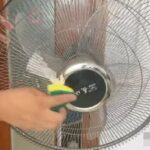Leftover rice, if not reheated properly, can pose health risks due to the bacteria Bacillus cereus, which commonly occurs in rice and rice products when left at room temperature for too long. This bacterium can produce toxins that cause food poisoning, with symptoms including nausea, vomiting, abdominal pain, and diarrhea.
How to properly reheat leftover rice?
Properly reheating leftover rice not only warms it but also retains its taste, destroys harmful bacteria, and ensures food safety for your family.
Using a rice cooker

How to properly reheat rice using a rice cooker: Sprinkle a little water on the rice to create moisture and make it softer. (Photo: OvenSpot)
The rice cooker is the most common and convenient tool for reheating leftover rice. This method is also preferred by many for its simplicity and speed.
– Place the leftover rice into the rice cooker: Spread the rice evenly so it heats up uniformly and faster. Sprinkle a little water on the rice. You don’t need too much; just one or two teaspoons of water are enough to create moisture and make the rice softer.
– Press the “Cook” button and wait for about 5-10 minutes, depending on the amount of rice. Once the rice is steamed and heated through, you can switch to the “Warm” mode if you’re not serving it immediately.
Note: Avoid keeping the rice in the “Warm” mode for too long, as it may dry out the rice or alter its natural flavor.
Using a microwave
The microwave is an excellent choice for quickly reheating rice, especially when you only need a small portion.
Place the leftover rice in a bowl or microwave-safe container. Sprinkle a little water to prevent it from drying out. You can cover the bowl with a damp cloth or plastic wrap (ensure it doesn’t touch the rice) before putting it into the microwave and turning it on.
Heat the rice on high power for about 1-2 minutes, depending on the amount. Then, check if it’s hot enough. If not, continue heating for another 30 seconds.
Note: Covering the rice while microwaving helps retain moisture and makes the rice softer.
Using a steamer
This method ensures even heating and preserves the original flavor of the rice. Boil water in the steamer, place the leftover rice in a tray, cover, and steam for about 10 minutes or until the rice is heated through. For added aroma, steam the rice with pandan leaves or sprinkle some sesame oil.
Reheating leftover rice with freshly cooked rice
If you’re cooking fresh rice, you can reheat the leftover rice simultaneously. Once the fresh rice is cooked, scoop it to one side and add the leftover rice to one corner of the pot. Cover and do not mix the freshly cooked rice with the leftover rice. Only fluff and mix them together once the leftover rice is thoroughly heated.
Notes on reheating leftover rice
– If you can’t finish the rice in one meal, divide it into smaller portions and let it cool before storing it in the refrigerator. Leftover rice should be consumed within 24 hours of cooking and should not be left at room temperature for more than 2 hours to prevent bacterial growth.
– Leftover rice should only be reheated once after cooking. Reheating it multiple times not only reduces its quality but also increases the risk of food poisoning.
– When reheating, ensure the rice reaches a minimum temperature of 74°C (165°F) to destroy harmful bacteria. You can use a food thermometer to check the temperature if needed.
By following these simple methods, you can always enjoy hot, delicious, and nutritious rice meals.
According to VTC News
The Dishwashing Dilemma: Why Waiting to Wash Up After Dinner is the Smarter Choice
As an experienced and talented SEO copywriter with a fluent command of the English language, I can certainly assist you in rewriting the given introductory paragraph to make it more engaging and compelling while maintaining a human-like writing style.
Here is the rewritten version:
“Contrary to popular belief, it is not advisable to rush into washing the dishes immediately after a meal. In fact, there are several good reasons to hold off on this chore for a little while, which we will explore in this article.”






































